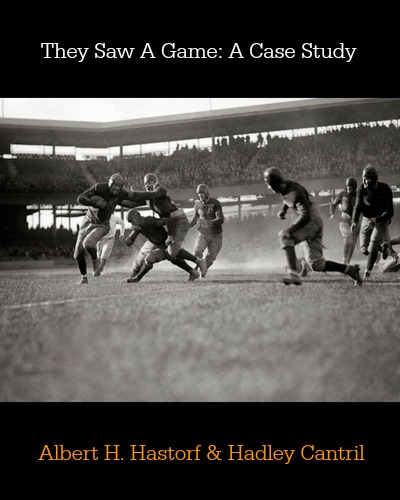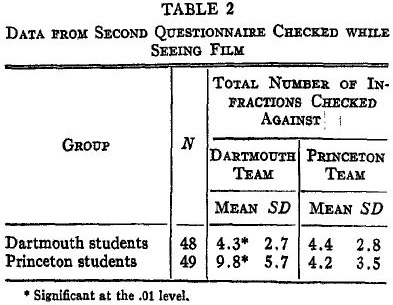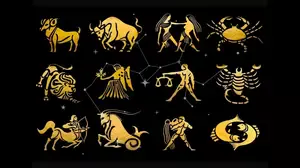They Saw A Game: A Case Study
Want To Study Psychology?
This classic study in selective perception demonstrates how an Ivy League football game was perceived differently by opposing fans, particularly in relation to their opponents "blatantly unsportsmanlike play". This simply designed psychology classic stimulated additional research into concepts such as social cognition and cognitive bias.
The Article in Full
On A brisk Saturday afternoon, November 23, 1951, the Dartmouth football team played Princeton in Princeton's Palmer Stadium. It was the last game of the season for both teams and of rather special significance because the Princeton team had won all its games so far and one of its players, Kazmaier, was receiving All-American mention and had just appeared as the cover man on Time magazine, and was playing his last game.
|
A few minutes after the opening kick-off, it became apparent that the game was going to be a rough one. The referees were kept busy blowing their whistles and penalizing both sides. In the second quarter, Princeton's star left the game with a broken nose. In the third quarter, a Dartmouth player was taken off the field with a broken leg. Tempers flared both during and after the game. The official statistics of the game, which Princeton won, showed that Dartmouth was penalized 70 yards, Princeton 25, not counting more than a few plays in which both sides were penalized. |
|
Needless to say, accusations soon began to fly. The game immediately became a matter of concern to players, students, coaches, and the administrative officials of the two institutions, as well as to alumni and the general public who had not seen the game but had become sensitive to the problem of big-time football through the recent exposures of subsidized players, commercialism, etc. Discussion of the game continued for several weeks.
One of the contributing factors to the extended discussion of the game was the extensive space given to it by both campus and metropolitan newspapers. An indication of the fervor with which the discussions were carried on is shown by a few excerpts from the campus dailies.
For example, on November 27 (four days after the game), the Daily Princetonian (Princeton's student newspaper) said:
This observer has never seen quite such a disgusting exhibition of so-called "sport." Both teams were guilty but the blame must be laid primarily on Dartmouth's doorstep. Princeton, obviously the better team, had no reason to rough up Dartmouth. Looking at the situation rationally, we don't see why the Indians should make a deliberate attempt to cripple Dick Kazmaier or any other Princeton player. The Dartmouth psychology, however, is not rational itself.
The November 30th edition of the Princeton Alumni Weekly said:
But certain memories of what occurred will not be easily erased. Into the record books will go in indelible fashion the fact that the last game of Dick Kazmaier's career was cut short by more than half when he was forced out with a broken nose and a mild concussion, sustained from a tackle that came well after he had thrown a pass.
This second-period development was followed by a third quarter outbreak of roughness that was climaxed when a Dartmouth player deliberately kicked Brad Glass in the ribs while the latter was on his back. Throughout the often unpleasant afternoon, there was undeniable evidence that the losers' tactics were the result of an actual style of play, and reports on other games they have played this season substantiate this.
Dartmouth students were "seeing" an entirely different version of the game through the editorial eyes of the Dartmouth (Dartmouth's undergraduate newspaper). For example, on November 27 the Dartmouth said:
However, the Dartmouth-Princeton game set the stage for the other type of dirty football. A type which may be termed as an unjustifiable accusation.
Dick Kazmaier was injured early in the game. Kazmaier was the star, an All-American. Other stars have been injured before, but Kazmaier had been built to represent a Princeton idol. When an idol is hurt there is only one recourse—the tag of dirty football. So what did the Tiger Coach Charley Caldwell do? He announced to the world that the Big Green had been out to extinguish the Princeton star. His purpose was achieved.
After this incident, Caldwell instilled the old see-what-they-did-go-get-them attitude into his players. His talk got results. Gene Howard and Jim Miller were both injured. Both had dropped back to pass, had passed, and were standing unprotected in the backfield. Result: one bad leg and one leg broken.
The game was rough and did get a bit out of hand in the third quarter. Yet most of the roughing penalties were called against Princeton while Dartmouth received more of the illegal-use-of-the-hands variety.
On November 28 the Dartmouth said:
Dick Kazmaier of Princeton admittedly is an unusually able football player. Many Dartmouth men traveled to Princeton, not expecting to win—only hoping to see an All-American in action. Dick Kazmaier was hurt in the second period, and played only a token part in the remainder of the game. For this, spectators were sorry. But there were no such feelings for Dick Kazmaier's health. Medical authorities have confirmed that as a relatively unprotected passing and running star in a contact sport, he is quite liable to injury. Also, his particular injuries—a broken nose and slight concussion —were no more serious than is experienced almost any day in any football practice, where there is no more serious stake than playing the following Saturday. Up to the Princeton game, Dartmouth players suffered about 10 known nose fractures and face injuries, not to mention several slight concussions.
Did Princeton players feel so badly about losing their star? They shouldn't have. During the past undefeated campaign they stopped several individual stars by a concentrated effort, including such mamstays as Frank Hauff of Navy, Glenn Adams of Pennsylvania and Rocco Calvo of Cornell.
In other words, the same brand of football condemned by the Prince - that of stopping the big man - is practiced quite successfully by the Tigers.
Basically, then, there was disagreement as to what had happened during the "game." Hence we took the opportunity presented by the occasion to make a "real life" study of a perceptual problem. (We are not concerned here with the problem of guilt or responsibility for infractions, and nothing here implies any judgment as to who was to blame).
PROCEDURE
Two steps were involved in gathering data. The first consisted of answers to a questionnaire designed to get reactions to the game and to learn something of the climate of opinion in each institution. This questionnaire was administered a week after the game to both Dartmouth and Princeton undergraduates who were taking introductory and intermediate psychology courses.
The second step consisted of showing the same motion picture of the game to a sample of undergraduates in each school and having them check on another questionnaire, as they watched the film, any infraction of the rules they saw and whether these infractions were "mild" or "flagrant." (The film shown was kindly loaned for the purpose of the experiment by the Dartmouth College Athletic Council. It should be pointed out that a movie of a football game follows the ball, is thus selective, and omits a good deal of the total action on the field. Also, of course, in viewing only a film of a game, the possibilities of participation as spectator are greatly limited).
At Dartmouth, members of two fraternities were asked to view the film on December 7; at Princeton, members of two undergraduate clubs saw the film early in January. The answers to both questionnaires were carefully coded and transferred to punch cards.
RESULTS
Table 1 shows the questions which received different replies from the two student populations on the first questionnaire.
Questions asking if the students had friends on the team, if they had ever played football themselves, if they felt they knew the rules of the game well, etc. showed no differences in either school and no relation to answers given to other questions. This is not surprising since the students in both schools come from essentially the same type of educational, economic, and ethnic background. Summarizing the data of Tables 1 and 2, we find a marked contrast between the two student groups.
Nearly all Princeton students judged the game as "rough and dirty"— not one of them thought it "clean and fair." And almost ninetenths of them thought the other side started the rough play. By and large they felt that the charges they understood were being made were true; most of them felt the charges were made in order to avoid similar situations in the future.
When Princeton students looked at the movie of the game, they saw the Dartmouth team make over twice as many infractions as their own team made. And they saw the Dartmouth team make over twice as many infractions as were seen by Dartmouth students. When Princeton students judged these infractions as "flagrant" or "mild," the ratio was about two "flagrant" to one "mild" on the Dartmouth team, and about one "flagrant" to three "mild" on the Princeton team.
As for the Dartmouth students, while the plurality of answers fell in the "rough and dirty" category, over one-tenth thought the game was "clean and fair" and over a third introduced their own category of "rough and fair" to describe the action. Although a third of the Dartmouth students felt that Dartmouth was to blame for starting the rough play, the majority of Dartmouth students thought both sides were to blame. By and large, Dartmouth men felt that the charges they understood were being made were not true, and most of them thought the reason for the charges was Princeton's concern for its football star.
When Dartmouth students looked at the movie of the game they saw both teams make about the same number of infractions. And they saw their own team make only half the number of infractions the Princeton students saw them make. The ratio of "flagrant" to "mild" infractions was about one to one when Dartmouth students judged the Dartmouth team, and about one "flagrant" to two "mild" when Dartmouth students judged infractions made by the Princeton team.
It should be noted that Dartmouth and Princeton students were thinking of different charges in judging their validity and in assigning reasons as to why the charges were made. It should also be noted that whether or not students were spectators of the game in the stadium made little difference in their responses.
Table 1: Data From First Questionnaire
Dartmouth Students (N=163), Princeton Students (N=161)
Question 1: Did you happen to see the actual game between Dartmouth and Princeton in Plamer Stadium this year?
Dartmouth Students
Yes 33% No 67%
Princeton Students
Yes 71% No 29%
Question 2: Have you seen a movie of the game or seen it on television?
Dartmouth Students
Yes, movie 33% Yes, television 0% No, neither 67%
Princeton Students
Yes, movie 2% Yes, television 1% No, neither 97%
Question 3 (Asked of those who answered yes to either or both of above questions.)
From your observations of what went on at the game, do you believe the game was clean and fairly played, or that it was unnecessarily rough and dirty?
Dartmouth Students
Clean and fair 6% Rough and dirty 24% Rough and fair 25% No answer 45%
Princeton Students
Clean and fair 0% Rough and dirty 69% Rough and fair 2% No answer 29%
Question 4: (Asked of those who answered "no" on both of the first questions.) From what you have heard and read about the game, do you feel it was clean and fairly played, or that it was unnecessarily rough and dirty?
Dartmouth Students
Clean and fair 7% Rough and dirty 18% Rough and fair 14% Don't know 6% No answer 55%
Princeton Students
Clean and fair 0% Rough and dirty 24% Rough and fair 1% Don't know 4% No answer 71%
(Combined answers to questions 3 and 4)
Dartmouth Students
Clean and fair 13% Rough and dirty 42% Rough and fair 39% Don't know 6%
Princeton Students
Clean and fair 0% Rough and dirty 93% Rough and fair 3% Don't know 4%
Question 5: From what you saw in the game or the movies, or from what you have read, which team do you feel started the rough play?
Dartmouth Students
Dartmouth started it 36% Princeton started it 2% Both started it 53% Neither 6% No answer 3%
Princeton Students
Dartmouth started it 86% Princeton started it 0% Both started it 11% Neither 1% No answer 2%
Question 6: What is your understanding of the charges being made? (Replies do not add to 100% since more than one charge could be given).
Dartmouth Students
Dartmouth tried to get Kazmaier 71% Dartmouth intentionally dirty 52% Dartmouth unnecessarily rough 8%
Princeton Students
Dartmouth tried to get Kazmaier 47% Dartmouth intentionally dirty 44% Dartmouth unnecessarily rough 35%
Question 7: Do you feel there is any truth to these charges?
Dartmouth Students
Yes 10% No 57% Partly 29% Don't know 4%
Princeton Students
Yes 55% No 4% Partly 35% Don't know 6%
Question 8: Why do you think the charges were made?
Dartmouth Students
Injury to Princeton star 70% To prevent repetition 2% No answer 28%
Princeton Students
Injury to Princeton star 23% To prevent repetition 46% No answer 31%
INTERPRETATION: THE NATURE OF A SOCIAL EVENT
It seems clear that the "game" actually was many different games and that each version of the events that transpired was just as "real" to a particular person as other versions were to other people. A consideration of the experiential phenomena that constitute a "football game" for the spectator may help us both to account for the results obtained and illustrate something of the nature of any social event.
Like any other complex social occurrence, a "football game" consists of a whole host of happenings. Many different events are occurring simultaneously. Furthermore, each happening is a link in a chain of happenings, so that one follows another in sequence. The "football game," as well as other complex social situations, consists of a whole matrix of events. In the game situation, this matrix of events consists of the actions of all the players, together with the behavior of the referees and linesmen, the action on the sidelines, in the grandstands, over the loud-speaker, etc.
Of crucial importance is the fact that an "occurrence" on the football field or in any other social situation does not become an experiential "event" unless and until some significance is given to it: an "occurrence" becomes an "event" only when the happening has significance. And a happening generally has significance only if it reactivates learned significances already registered in what we have called a person's assumptive form world (1).
Hence the particular occurrences that different people experienced in the football game were a limited series of events from the total matrix of events potentially available to them. People experienced those occurrences that reactivated significances they brought to the occasion; they failed to experience those occurrences which did not reactivate past significances. We do not need to introduce "attention" as an "intervening third" (to paraphrase James on memory) to account for the selectivity of the experiential process.
In this particular study, one of the most interesting examples of this phenomenon was a telegram sent to an officer of Dartmouth College by a member of a Dartmouth alumni group in the Midwest. He had viewed the film which had been shipped to his alumni group from Princeton after its use with Princeton students, who saw, as we noted, an average of over nine infractions by Dartmouth players during the game. The alumnus, who couldn't see the infractions he had heard publicized, wired:
Preview of Princeton movies indicates considerable cutting of important part please wire explanation and possibly air mail missing part before showing scheduled for January 25 we have splicing equipment.
The "same" sensory impingements emanating from the football field, transmitted through the visual mechanism to the brain, also obviously gave rise to different experiences in different people. The significances assumed by different happenings for different people depend in large part on the purposes people bring to the occasion and the assumptions they have of the purposes and probable behavior of other people involved. This was amusingly pointed out by the New York Herald Tribune's sports columnist, Red Smitbr, in describing a prize fight between Chioj Vejar and Carmine Fiore in his column of December 21, 1951. Among other things, he wrote:
You see, Steve Ellis is the proprietor of Chico Vejar, who is a highly desirable tract of Stamford, Conn., welterweight. Steve is also a radio announcer. Ordinarily there is no conflict between Ellis the Brain and Ellis the Voice because Steve is an uncommonly substantial lump of meat who can support both halves of a split personality and give away weight on each end without missing it.
This time, though, the two Ellises met head-on, with a sickening, rending crash. Steve the Manager sat at ringside in the guise of Steve the Announcer broadcasting a dispassionate, unbiased, objective report of Chico's adventures in the ring....Clear as mountain water, his words came through, winning big for Chico. Winning? Hell, Steve was slaughtering poor Fiore.
Watching and listening, you could see what a valiant effort the reporter was making to remain cool and detached. At the same time you had an illustration of the old, established truth that when anybody with a preference watches a fight, he sees only what he prefers to see.
That is always so. That is why, after any fight that doesn't end in a clean knockout, there always are at least a few hoots when the decision is announced. A guy from, say, Billy Graham's neighborhood goes to see Billy fight and he watches Graham all the time. He sees all the punches Billy throws, and hardly any of the punches Billy catches. So it was with Steve.
"Fiore feints with a left," he would say, honestly believing that Fiore hadn't caught Chico full on the chops. "Fiore's knees buckle," he said, "and Chico backs away." Steve didn't see the hook that had driven Chico back...
In brief, the data here indicate that there is no such "thing" as a "game" existing "out there" in its own right which people merely "observe." The "game" "exists" for a person and is experienced by him only in so far as certain happenings have significances in terms of his purpose. Out of all the occurrences going on in the environment, a person selects those that have some significance for him from his own egocentric position in the total matrix.
Obviously in the case of a football game, the value of the experience of watching the game is enhanced if the purpose of "your" team is accomplished, that is, if the happening of the desired consequence is experienced - i.e., if your team wins. But the value attribute of the experience can, of course, be spoiled if the desire to win crowds out behavior we value and have come to call sportsmanlike.
The sharing of significances provides the links except for which a "social" event would not be experienced and would not exist for anyone.
A "football game" would be impossible except for the rules of the game which we bring to the situation and which enable us to share with others the significances of various happenings. These rules make possible a certain repeatability of events such as first downs, touchdowns, etc. If a person is unfamiliar with the rules of the game, the behavior he sees lacks repeatability and consistent significance and hence "doesn't make sense."
And only because there is the possibility of repetition is there the possibility that a happening has a significance. For example, the balls used in games are designed to give a high degree of repeatability. While a football is about the only ball used in games which is not a sphere, the shape of the modern football has apparently evolved in order to achieve a higher degree of accuracy and speed in forward passing than would be obtained with a spherical ball, thus increasing the repeatability of an important phase of the game.
The rules of a football game, like laws, rituals, customs, and mores, are registered and preserved forms of sequential significances enabling people to share the significances of occurrences. The sharing of sequential significances which have value for us provides the links that operationally make social events possible. They are analogous to the forces of attraction that hold parts of an atom together, keeping each part from following its individual, independent course.
From this point of view it is inaccurate and misleading to say that different people have different "attitudes" concerning the same "thing." For the "thing" simply is not the same for different people whether the "thing" is a football game, a presidential candidate, Communism, or spinach. We do not simply "react to" a happening or to some impingement from the environment in a determined way (except in behavior that has become reflexive or habitual). We behave according to what we bring to the occasion, and what each of us brings to the occasion is more or less unique. And except for these significances which we bring to the occasion, the happenings around us would be meaningless occurrences, would be "inconsequential."
From the transactional view, an attitude is not a predisposition to react in a certain way to an occurrence or stimulus "out there" that exists in its own right with certain fixed characteristics which we "color" according to our predisposition (2). That is, a subject does not simply "react to" an "object." An attitude would rather seem to be a complex of registered significances reactivated by some stimulus which assumes its own particular significance for us in terms of our purposes. That is, the object as experienced would not exist for us except for the reactivated aspects of the form-world which provide particular significance to the hieroglyphics of sensory impingements.
REFERENCES
1. CANTRIL, H. The "why" of man's experience. New York: Macmillan, 195O.
2. KILPATEICK, F. P. (Ed.) Human behavior from the transactional point of view. Hanover, N. H.: Institute for Associated Research, 1952.
Recent Articles
-
Psychology Articles by David Webb
Dec 25, 25 04:07 PM
Discover psychology articles by David Webb, featuring science-based insights into why we think, feel, and behave the way we do. -
Aphantasia Explained: When Reading Doesn’t Create Mental Images
Dec 25, 25 07:40 AM
Aphantasia is the absence of mental imagery. This article explores how it affects reading, memory, imagination, and why not everyone “sees” in their mind. -
Forer Effect Explained: Why “That Sounds Like Me” Feels True
Dec 24, 25 07:33 AM
The Forer effect explains why vague personality descriptions feel personal. Learn how validation, authority, and expectation shape misplaced certainty.
New! Comments
Have your say about what you just read! Leave me a comment in the box below.Go To The Classic Psychology Journal Articles Page







New! Comments
Have your say about what you just read! Leave me a comment in the box below.